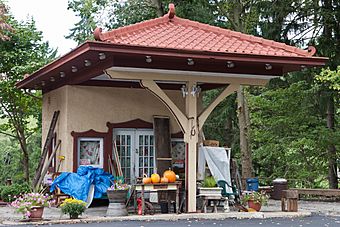Centerville Historic District (Centerville, Pennsylvania) facts for kids
Quick facts for kids |
|
|
Centerville Historic District
|
|

The John Williams Service Station is part of the Centerville Historic District.
|
|
| Location | Roughly, Old National Pike--US 40 from Linton Rd. to jct. ofOld National Pike--US 40 and PA 481, Centerville, Pennsylvania |
|---|---|
| Area | 25 acres (10 ha) |
| Built | 1821 |
| Architectural style | Mid 19th Century Revival, Late Victorian, Late 19th And 20th Century Revivals |
| MPS | National Road in Pennsylvania MPS |
| NRHP reference No. | 96001208 |
| Added to NRHP | October 24, 1996 |
The Centerville Historic District is a special area in Centerville, Pennsylvania, recognized for its important history. It's like a time capsule that shows what towns were like along the famous National Road in Pennsylvania.
Today, Centerville isn't as busy with shops as it once was. But it still has ninety-four old buildings. These include places like taverns (old inns), homes, shops, and service buildings. They all tell the story of how the National Road helped the town grow and then how things changed.
The Washington County History & Landmarks Foundation has named Centerville a historic district. It's also listed on the National Register of Historic Places. This means it's officially recognized as an important historical site.
Contents
What is a Historic District?
A historic district is a neighborhood or area with many buildings that share a common history or architectural style. These areas are protected to keep their unique character. They help us remember the past and understand how people lived long ago.
Centerville: A "Pike Town" on the National Road
Centerville is a great example of a "pike town." This is a town that grew up along a major road, often called a "pike" in the past. The most important road for Centerville was the National Road.
The National Road: America's First Highway
The National Road was one of the first major improved highways in the United States. It was built in the early 1800s to connect the eastern states with the growing western frontier. Imagine a time before cars and airplanes! People traveled by horse, wagon, or stagecoach. The National Road was vital for moving goods and people across the country.
Towns like Centerville popped up along the National Road to serve travelers. They offered places to rest, eat, and buy supplies.
Buildings in the District
The Centerville Historic District covers about 25 acres. It includes many different types of buildings from the 19th and early 20th centuries.
Homes and Shops
Many of the buildings are old homes. Some of these homes also had small shops or businesses on the ground floor. This was common when people often lived and worked in the same building.
Taverns and Inns
Taverns were very important in pike towns. They were like hotels and restaurants combined. Travelers on the National Road would stop at these taverns to spend the night, get a meal, and rest their horses. These buildings were often bustling centers of activity.
Service Buildings
The district also includes buildings that provided services needed by travelers and locals. This might include places where wagons could be repaired or where horses could be cared for.
Why is Centerville Important?
Centerville is important because it shows us what life was like along the National Road. It's a well-preserved example of how these towns developed. The buildings tell stories of the people who lived and worked there, and how they helped shape early American travel and trade.
By protecting places like the Centerville Historic District, we can learn about our past and keep these valuable stories alive for future generations.



